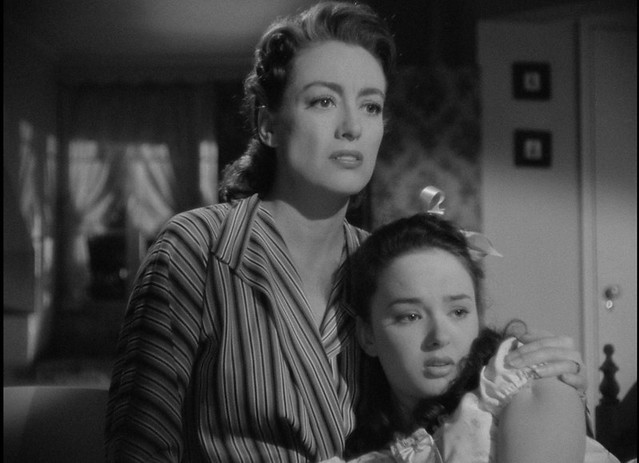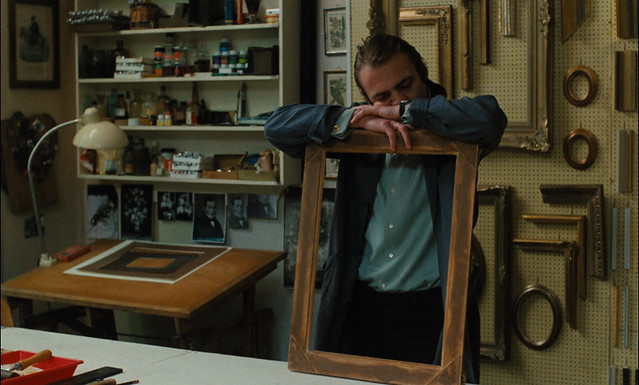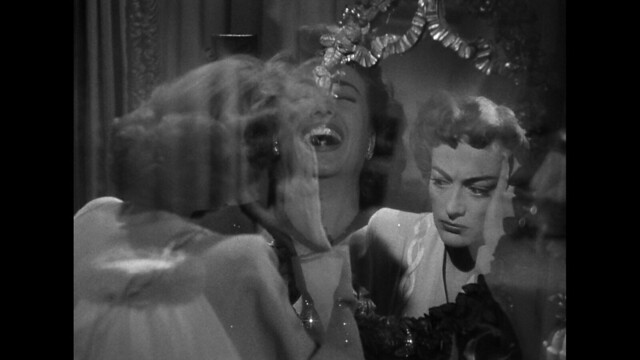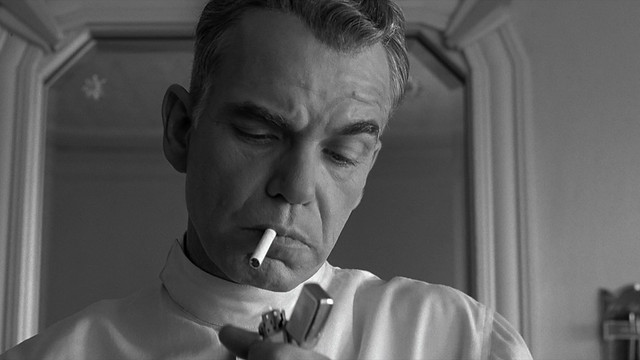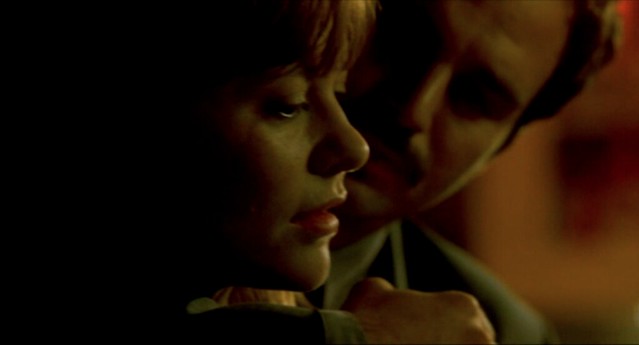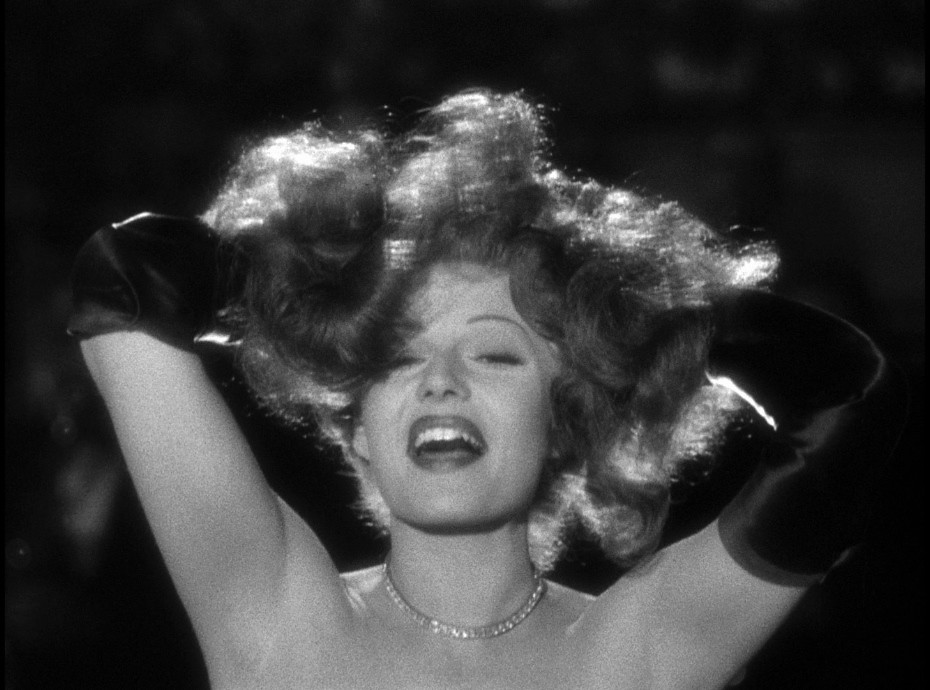Michael Curtis is almost the perfect inverse of my issue with Nicholas Ray. While I find Ray’s work to be filled with personality (ie: sadness) on a narrative level, I find his use of imagery to be only adequate. Curtiz on the other hand, has a gorgeous visual sense with nothing thematically holding his body of work together as a whole. And so, Ray is oft held up as an Auteurist God, while Curtiz is dismissed as a competent craftsman. They dismiss the genius of William Wyler and Robert Wise for the same reasons. And while I agree that their filmographies cannot be read like a novel, it’s foolhardy to dismiss individual films for this reason alone. Andrew Sarris wrote of forests and trees, can't we have both? Why do they have to be mutually exclusive? I’d argue that the closing moments of The Breaking Point are bolder than most studio pictures of the era. I’m glad Criterion saw fit to bring it into the fold as a work that is worthy of attention.
Showing posts with label noir. Show all posts
Showing posts with label noir. Show all posts
Thursday, November 16, 2017
Wednesday, November 15, 2017
On Dangerous Ground (1951)
“Nicholas Ray is Cinema.” - Jean-Luc Godard
I’ve been wrestling with that statement for the better part of two decades. Let me state up front that I don’t dislike his films. I’ve seen six and have enjoyed them all. They’re good pictures, capably told, and filled with immense sadness. But is that the epitome of Cinema? Ray is often revered for his use of the wide-screen frame, but to my eye, it’s purely functional. Not bad, but functional. And what of the films he made before CinemaScope? But there is also no denying that he is an auteur. The sadness I spoke of earlier is uniquely his. It’s there in all of the films I’ve watched so far: sadness and regret.
The more I reflect on it, Godard’s statement was the mid-century equivalent of clickbait. Simply stating that someone is a good director who makes films you relate to was not enough! It was especially not enough in an era when genre films were thought of as trash and directors seen as little more than glorified traffic cops. Godard’s hyperbole did the trick at the time and placed necessary attention on a serious artist. But is Nick Ray truly the be all and end all of Cinema? I don’t think so. I don’t think any artist can ever truly epitomize all of their medium’s endless possibilities. If this was possible, what would be the point of any other mere mortal picking up a camera? Nicholas Ray is a very good director. Let’s just leave it at that.
Monday, April 17, 2017
Detective Story (1951)
Theatre and Film share so much in common, yet in very crucial ways they're worlds apart. They both use actors, sets, costumes and lighting. They both rely on scripts and are viewed by theaters full of people. But translating a good play to the screen is actually rather challenging. Often the finished film will betray its origins as a play through its limited number of locations. You feel like there is no real world outside the set where this story is taking place. That's certainly not the case with this William Wyler adaptation. This film is alive! People come in and out, this character interacts with that character, etc. It feels like a real police precinct where we are but a fly on the wall. And like a real fly, we get to move all over the place and see everything from the best angles. People who say Wyler was a lesser director can go take a long walk off a short pier.
Thursday, March 9, 2017
Mildred Pierce (1945)
Veda is the perfect scapegoat. Remove her from this film and you have the story of a woman who is destroyed by her ambitious quest for the American Dream that we are all told to want. With her, you have the story of this poor woman whose only sin was that she cares too much. Did James M. Cain intend for her to be a cipher? She's this perfect void that will never be filled no matter how much love or money you throw at it. She's both voracious and insatiable. Just when you think you've got it all with your chain of restaurants and nice house, along comes Veda to throw a new wrench into the perfectly running machinery. It's a series of false peaks that leads only to destruction. But I didn't do it for me. I did it for her! There is no happy end. When you fall down a bottomless pit, you die of starvation.
Monday, December 5, 2016
The American Friend (1977)
This is an interesting one. It feels the most autobiographical of the Wim Wenders films I've seen. The cameos by Sam Fuller and Nicholas Ray, the dedication to Henri Langlois and the inclusion of early optical toys clearly indicate that Wenders wants us to be thinking about cinema itself. Viewed in this context, the forgery subplot seems like a knowing nod towards his early career, where Wenders himself acknowledges that his directing "style" consisted of little more than approximating Hitchcock and Cassavetes. Even the Zimmerman character agreeing to serve as a hired gun seems to pre-sage the difficulties Wim would later encounter trying to work for Francis Ford Coppola on Hammett. Yet by placing all of this within the context of a "crime picture", Wenders is able to sidestep the indulgence of making a "struggling artist picture". It's not an entirely perfect marriage, but it sure makes for some interesting images, ideas and an amazing train sequence.
Thursday, November 17, 2016
Possessed (1947)
In film school we learned a lot about the "classical Hollywood style". The central tenet of this "style" was to create a seamless experience where the audience is continuously enveloped in the story, and great pains are taken to preserve that illusion. Edits and camera movements are placed very strategically so that you do not notice them. While I'm pretty sure it was unintentional, throughout this film I was repeatedly made aware that I was watching a deliberate construct.
Right near the opening you have Joan Crawford walking down real Los Angeles streets, then you cut to her walking up to and into a restaurant that is very obviously a set. And then there are camera moves like the POV shot of Joan being wheeled into the hospital. Nothing seamless about a shot like that. Even the ways in which Crawford is lit to maximize her Joan-ness is a bit distracting.
When you later find out that her character is sometimes unable to distinguish reality from fantasy, I started to wonder if the clashing of styles was deliberate. Was director Curtis Bernhardt subtly preparing us for later reveals and shocks? Was he making a comment on the inherent falseness of the cinema? Judging by his filmography, I'm thinking not. But I love when a work of art allows my mind to roam to such places. That's what makes movies great. You can have your own little theories about them, like how The Shining was Kubrick's way of telling us the truth about the Moon Landing...
Monday, September 19, 2016
The Man Who Wasn't There (2001)
Somewhere among the masterpieces, the failures and the crowdpleasers, this film tends to get forgotten in the Coen Brothers oeuvre. Even though it shared Best Director at Cannes with the newly ordained "Best Film of the Millennium" Mulholland Drive, The Man Who Wasn't There has become a bit of a phantom film. Sometimes I even wonder if it actually exists. But there it is on my self. It's almost too perfect that this film about an extremely passive and forgettable schlub, has itself become forgotten. And just like its protagonist, the film also holds surprising depth. That's the sort of extra-textual synthesis that you simply cannot plan. Or maybe the Coen's can?
Thursday, September 15, 2016
In the Cut (2003)
If I were a filmmaker, I would not want to get anywhere near this material. Due to my privilege as a straight, cis-gender male, I've never had to constantly fear for my safety the way a female, homosexual, or trans person does. I don't have to worry about roughly half of the world's population potentially wishing me harm. The threat of physical and sexual violence is completely alien to me. Yet, as an audience member I find this topic to be extremely compelling. Through Jane Campion and Meg Ryan I am able to glimpse that experience from the comfort and safety of my own sofa. Only a female, trans, or queer filmmaker could have told this story. Imagine some straight, male director talking about how the danger of everyday life can sometimes be a turn on. No way! What danger do they know? Although, a male person of color does know the unique terror of living in a world where black lives don't seem to matter. You know, the more I think about it, this story isn't very niche at all. The only group this is a foreign idea to is the tiny minority group of straight, white, cis-gender males. And that is the power of cinema.
Thursday, January 28, 2016
Gilda (1946)
As much as I love Film Noir, like many of the classic genres, it also has a bit of an anti-woman streak. The term "Femme Fatale" was even invented to describe the seductive women who drive numerous Noir Protagonists to ruin. These Femmes are almost exclusively cardboard characters with nothing but greed and sex on the brain. They get to take the rap for all of man's troubles. Walter Neff of Double Indemnity certainly would have NEVER become a murderer if not for the manipulative Mrs. Dietrichson exploiting his libido. Everything is the woman's fault. They get to take the blame.
What makes Gilda so fascinating to me is how bluntly the film and the character actually call out that particularly misogynist convention. Numerous times throughout the movie we get to hear Gilda singing and humming about female scapegoating via the facetious song "Put the Blame on Mame". It's her de facto theme. She is tragically aware of how she is perceived. When we see her singing it alone with a guitar we can't help but sense how pinned down she is by this gender construct. Later on, we get to see her deliberately take command of that role and play it to her advantage.
In an era full of one-dimensional vamps, Gilda was at least allowed to have levels. Through the miracle of Rita Hayworth, we were given one of Film Noir's first real human women.
Monday, November 18, 2013
Hard Eight (1996)
A mysterious older man named Sydney (Philip Baker Hall) takes a young man (John C. Reilly) under his wing and helps him to get on his feet. Why is he doing this? You'll have to watch to find out.
* * *
Stories don’t have endings. Fades to black, curtain calls and last pages may give us a sense of closure, but the story does not stop there. That’s just the moment where the author decided to stop following those particular characters. When Superman and Zod knock down a building, it is filled with people who have lives and families. Actions have consequences and the best films have consequences that continue to echo long after the screen has read, “The End”. Though not preceded by any particular film, Paul Thomas Anderson’s feature debut is a story about what happens after that final reel. It’s a sequel without a prequel.
While nowhere near as flashy as Anderson’s later films, Sydney (the director's preferred title) ably casts a spell on you with its floating camera and dreamlike score as it unravels its haunting yarn about guilt, family, secrets and the awful things one will do to keep those secrets. Things that cannot be simply erased by a cut to black. A cut to black merely sweeps bad things under the rug for a while where they can lie in wait. As many characters in one of Anderson’s later films state: "We may be through with the past, but the past is not through with us."
While nowhere near as flashy as Anderson’s later films, Sydney (the director's preferred title) ably casts a spell on you with its floating camera and dreamlike score as it unravels its haunting yarn about guilt, family, secrets and the awful things one will do to keep those secrets. Things that cannot be simply erased by a cut to black. A cut to black merely sweeps bad things under the rug for a while where they can lie in wait. As many characters in one of Anderson’s later films state: "We may be through with the past, but the past is not through with us."
Tuesday, September 4, 2012
Leave Her To Heaven (1945)
Socialite Ellen Berent (Gene Tierney) meets and falls in love with writer Richard Harland (Cornel Wilde). They marry, and appear to be an ideal pair. But, as luck would have it, she turns out to be obsessive, jealous, and capable of evil things nobody thought possible.
I'm so happy this film is in Technicolor. Gene Tierney's face is a work of art. And she's SO good in this. It seems I've been watching a lot of crazy-women-movies lately (Fatal Attraction, Play Misty For Me, The Hand That Rocks The Cradle, Misery) and I was happy to revisit this one. It's pretty campy at parts (The film has Vincent Price in a supporting role...I think he drags camp behind him wherever he goes) but it's also very dark. The bad girls of 40s cinema don't get much more twisted than this! Add Jeanne Crain as her saintly (and equally stunning) sister, the beautiful scenery (although the matte painting in the background are at times laughably obvious) and the insane story, and you've got yourself a good way to spend a couple hours.
Enjoy, and don't let Gene Tierney take you swimming!

Labels:
'becca'lise,
crime,
drama,
noir
Monday, June 4, 2012
The Long Goodbye (1973)
After helping a buddy escape to Mexico, private investigator Philip Marlowe (Elliott Gould) must deal with a ton of cops and criminals who are after the guy. Also he's got a case to crack so that he can feed his cat.
* * *
Until tax incentives made it cheaper to shoot elsewhere, a majority of America's film output was shot in Los Angeles. There's even a great documentary called Los Angeles Plays Itself about all the various ways the city has been used in film over the decades. That being said, there are really only a handful of films that have truly been able to capture this odd, sprawling city of streets and freeways. One of the most difficult aspects to capture is the light. When smog and the sun combine they make this wonderful haze that is uniquely Los Angeles. And thanks to a technique called "flashing", director Robert Altman and cinematographer Vilmos Zsigmond were able to capture that special haze to give us the perfect melding of theme, setting and style. Can you really think of a more appropriate visual metaphor for this film than bright healthy sunshine filtered through a layer of thick sleaze?
Tuesday, May 15, 2012
Touch Of Evil (1958)
A car-bombing on the US/Mexico border pits a righteous Mexican cop (Charleton Heston) against his corrupt gringo counterpart (Orson Welles).
* * *
I know everyone loves to hold up Citizen Kane as the ultimate auteur film, but I'd like to make the case for a different Orson Welles film. In the hands of a lesser filmmaker, Touch Of Evil could have been absolute trash. Yet despite the cheap title, incomprehensible plot, Charlton Heston playing a Mexican and numerous scenes of an innocent white woman being menaced by lustful Latinos, it's actually a rather amazing film. This is all due to Welles and his camera. Right from the beginning with the endless crane-shot, you are made aware that this is not your average suspense-thriller. And from there the train just keeps rolling. So what if the source material is crap? Orson swung for the fences...and knocked it out of the park! As his 58-page memo critiquing the studio's tinkering with the final cut can attest, he was playing for keeps. Which brings me back to where we began: Citizen Kane had the benefit of an extremely solid (and Oscar winning) script, this film had only Orson. His iconoclastic style was the film's salvation.
Thursday, March 22, 2012
Blade Runner (1982)
Deckard (Harrison Ford) is a Blade Runner charged with hunting down and killing a group of rogue cyborgs known as Replicants.
* * *
I know this might make me sound like a heretic (especially with everyone (myself included) fawning all over the Prometheus trailer) but I don't really worship at the altar of Ridley Scott. While I do find his work consistently beautiful and beyond reproach in technique, rarely do I find myself giving a shit about any of his characters. Once the movie is over, it's over. I don't really think about it anymore. Blade Runner is a notable exception. Though in an interesting twist, the characters I feel for are the non-humans. I empathize with the Replicants. These poor guys and gals are already cursed with a drastically limited lifespan, and then along comes angel-of-death Deckard to make their lives even shorter. They just want more life. Is that really so bad? Isn't that what we all want? What would you do to live another day?
Thursday, March 1, 2012
Gun Crazy (1950)
Marksman Barton Tare (John Dall) and sharpshooter Peggy Cummins (Annie Laurie Star) set out on a passionate crime-wave, destined to end in tragedy.
* * *
When millions upon millions are on the line, everyone tends to play it safe. This is why most films through the 1960s were shot entirely on sound-stages. Hitchcock famously shot only the wide-shots on location and then retreated to a studio for the close-ups. God forbid reality enter the frame in any way. Absolutely nothing was left to chance. Director Joseph H. Lewis on the other hand, had a slightly different philosophy...
Tuesday, February 7, 2012
The Killing (1956)
A group of men conspire to pull off a daring robbery at a racetrack.
* * *
I have no way of proving it, but I have a strong inkling that this was a very personal film for Stanley Kubrick. Like Sterling Hayden's character Johnny, Stanley was a notorious perfectionist and a meticulous planner. Both went about their work in a very methodical manner, planning everything out to the smallest detail. There are plans and back-up plans. According to legend, Kubrick would spend weeks shooting simple scenes to make sure they were exactly as he had intended. Unfortunately there are no second takes when it comes to robbing a racetrack. The littlest hiccup starts a domino effect which brings the whole operation crashing down. While most people would identify this as Film Noir, I'm pretty sure Stanley would call this a horror film.
Monday, January 16, 2012
L.A. Confidential (1997)
Three cops (Guy Pearce, Russell Crowe and Kevin Spacey) are investigating murder, vice and corruption in 1950s Los Angeles.
* * *
I saw L.A. Confidential long before I ever read a James Ellroy novel. Having now become very familiar with the author and having read four of his novels, I can accurately say that the film of L.A. Confidential bares only a passing resemblance to the cynical, brutally violent, racist universe that runs through his work. But I can also accurately say that L.A. Confidential is an amazing piece of cinema! No novel has ever made it to the screen 100% intact. It's pointless to judge the movie against the book. A movie shouldn't ever be able to tarnish your love of a book and vice versa. A book is a book and a movie is a movie. Judge each on it's own terms.
Wednesday, May 18, 2011
Breathless (1960)
After stealing a car and killing a cop, Michel (Jean-Paul Belmondo) needs to lay-low. And lay he does, with the beautiful American newspaper girl Patricia (Jean Seberg), but can she be trusted?
* * *
Watching a Jean-Luc Godard film can be a challenge. Expressing how he was feeling that day on set ALWAYS trumps plot. And as the 1960s progressed (war, riots, divorce) Godard's feelings and films became gradually more morose. This is why I recommend his first film, Breathless. The sheer energy of it is astounding. You can tell that Godard had a lot on his mind and was aching to get it all out at once. By the end of this cinematic tornado of staccato jump-cuts and free-wheeling camera moves, you feel as though you've run a marathon. You find yourself literally...breathless.
Labels:
craig,
france,
french new wave,
noir
Subscribe to:
Posts (Atom)




